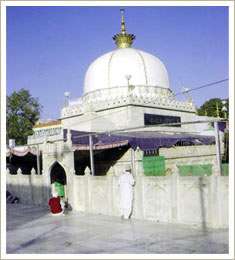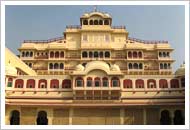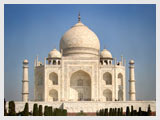+91 858 886 6045
Pushkar Fair Tour with Golden Triangle
Duration: 08 Night – 09 Days
Routing: Delhi - Ajmer - Pushkar - Jaipur - Agra - Delhi
Detailed Itinerary
Day 01: Delhi
Arrive at International airport, after traditional 'Swagat' (Welcome) our representative would assist you at New Delhi Railways station & transfer to hotel for check in.
 Delhi is a bustling metropolis, which successfully combines in its folds the ancient with modern. Its strategic location was the prime reasons why successive dynasties chose it as their seat of power. In fact, more mythological cities are believed to be here, like the city of Indraprastha from the Hindu epic Mahabharata, founded around 5000 BC. Numerous monuments were built over several centuries by different rulers like Qutub–ud–din Aibek, Alauddin Khilji, Tughlaks, Humayun & Shah Jahan, who built the Walled City Shah Jahanabad.
Delhi is a bustling metropolis, which successfully combines in its folds the ancient with modern. Its strategic location was the prime reasons why successive dynasties chose it as their seat of power. In fact, more mythological cities are believed to be here, like the city of Indraprastha from the Hindu epic Mahabharata, founded around 5000 BC. Numerous monuments were built over several centuries by different rulers like Qutub–ud–din Aibek, Alauddin Khilji, Tughlaks, Humayun & Shah Jahan, who built the Walled City Shah Jahanabad.
Later in first half of 20th century much of New Delhi was planned by Sir Edwin Lutyens, who laid out a grandiose central administrative area as a testament to British rule in India. The division in walled city & New Delhi also marks the division in life styles.
Overnight hotel – Delhi (B)
Day 02: Delhi
Full day
In New Delhi, we visit Raj Ghat, memorial to the Father of the Nation, Mahatma Gandhi. It is a simple black marble platform that marks the spot of his cremation on 31 January 1948. Further we drive past India Gate, memorial built in the year 1931 to commemorate the Indian soldiers who died in the World War I & the Afghan Wars. The names of the soldiers who died in these wars are inscribed on the walls. President's House, the official residence of the President of India, built in the year 1931. Until 1950 it was known as Viceroy's House & served as the residence of the Governor–General of British India.
We will also visit Humayun's Tomb, memorial of Mughal Emperor Humayun, built in the year 1562. The complex is a World Heritage Site & the first example of this type of Mughal architecture in India. Qutub Minar, built in the year 1206 by Qutub–ud–din Aibek. It is the tallest (72m) brick minaret in the world, an important example of Indo–Islamic Architecture. Qutub Minar & its monuments are listed as a UNESCO World Heritage Site.
Overnight Hotel – Delhi (B)
Day 03: Delhi – Ajmer
 Today we transfer in the morning to the train station to board our train for Ajmer situated in the green oasis wrapped in the barren hills has been a witness to an interesting past. The city was founded by Raja Ajay Pal Chauhan in the 7th Century AD & continued to be a major center of the Chauhan power till 1193 A.D. when Prithviraj Chauhan lost it to Mohammed Ghauri. Since then, Ajmer became home to many dynasties, which came & left leaving behind indelible marks of their culture & traditions on the city's history, converting it to an amalgam of various cultures & blend of Hinduism & Islam. We arrive Ajmer just around Lunch time, then we drive to Pushkar to our hotel .
Today we transfer in the morning to the train station to board our train for Ajmer situated in the green oasis wrapped in the barren hills has been a witness to an interesting past. The city was founded by Raja Ajay Pal Chauhan in the 7th Century AD & continued to be a major center of the Chauhan power till 1193 A.D. when Prithviraj Chauhan lost it to Mohammed Ghauri. Since then, Ajmer became home to many dynasties, which came & left leaving behind indelible marks of their culture & traditions on the city's history, converting it to an amalgam of various cultures & blend of Hinduism & Islam. We arrive Ajmer just around Lunch time, then we drive to Pushkar to our hotel .
Pushkar, an enchanting small town located exactly on the edge of the desert but is separated from it by Nag Pahar, the Snake Mountain. The town frequently visited by devotees lies to the side of the small Pushkar Lake with its multitudes of bathing ghats & temples. It also holds the most unique fairs of its kind in the world. It is a combination of an animal fair & the religious fair. Both the fairs are enchanting & have their own unique aspects & quality. As per the Indian calendar the fair is held in the first lunar cycle in the month of Kartik culminating on the Kartik Poornima (Full moon).
Overnight hotel–Pushkar (B)
Day 04: Pushkar Fair
Today whole day visit Pushkar Fair
Overnight hotel – Pushkar (B)
Day 05: Pushkar – Jaipur (150 kms – 03 hours)
Today we drive to Jaipur, popularly known as Pink City, the flamboyant & colourful capital of Rajasthan. With its rich & colourful past, resplendent with tales of valour & bravery, it is now one of the most important heritage cities in India. The city was founded in 1728 by Maharaja Sawai Jai Singh II, the ruler of Amber. It remains the only city in the world symbolizing the nine divisions of the universe, through nine rectangular sectors.
Overnight Hotel – Jaipur (B)
Day 06: Jaipur
Full Day Tour
 Today we take an excursion to Amber Fort (11 km); the palace complex which stands to this date was commenced under the reign of Raja Man Singh. We take an Elephant ride to reach the Fort situated on the hill, an overwhelming experience.
Today we take an excursion to Amber Fort (11 km); the palace complex which stands to this date was commenced under the reign of Raja Man Singh. We take an Elephant ride to reach the Fort situated on the hill, an overwhelming experience.
Later we visit the City Palace, a perfect blend of Rajasthani & Mughal architecture. The center of the palace is a seven–storied building called Chandra Palace, with fine views over the gardens & the city. Further we visit Jantar Mantar, the Solar Observatory, an astronomical treasure house, with solar devices that give accurate predictions till date. We now visit Hawa Mahal (Palace of Winds), a five–storied structure of pink sandstone. It was built in year 1799 so that veiled royal women could peer down unseen by the world through its 593 stone Jharokas (mini windows).
Overnight Hotel – Jaipur (B)
Day 07: Jaipur – Agra via Fatehpur Sikri (260 km – 6 hr)
Today we drive to Agra, en route we will visit Fatehpur Sikri (Ghost Capital), the political capital of India's Mughal Empire under Akbar's reign, from 1571 until 1585, when it was abandoned, ostensibly due to lack of water.
Further we continue our drive to Agra, beautifully situated on the banks of river Yamuna. It achieved prominence as the capital of the Mughal Emperors from 1526 to 1628, remains major tourist destination because of its many splendid Mughal–era monuments, most notably the Taj Mahal, Agra Fort & Fatehpur Sikri, all three of which are UNESCO World Heritage site.
Overnight Hotel – Agra (B)
Day 08: Agra
Full Day Tour
 Today we visit Taj Mahal, symbol of eternal love, which stands on the banks of River Yamuna. It was built by the 5th Mughal emperor, Shah Jehan in the year 1631in memory of his wife, Mumtaz Mahal. It was completed in 22 years. Further we visit Agra Fort, taken over from the Lodhis by the Mughal Emperor Akbar in the late 16th century. The Fort can be more accurately described as a walled palatial city. It was built from red sandstone, often inlaid with white marble & intricate decorations.
Today we visit Taj Mahal, symbol of eternal love, which stands on the banks of River Yamuna. It was built by the 5th Mughal emperor, Shah Jehan in the year 1631in memory of his wife, Mumtaz Mahal. It was completed in 22 years. Further we visit Agra Fort, taken over from the Lodhis by the Mughal Emperor Akbar in the late 16th century. The Fort can be more accurately described as a walled palatial city. It was built from red sandstone, often inlaid with white marble & intricate decorations.
We will also visit Sikandara, Akbar's tomb. His son Jahangir completed the construction of the tomb in the year 1613. Itmad–Ud–Daulah's Tomb, built by Nur Jahan between 1622 and 1628. It belongs to the father of Nur Jahan, Ghiyas–ud–Din Beg. He was the Wajir (Chief Minister of Emperor Jehangir). This white marble tomb was. This tomb was the first complete marble Mughal structure.
Overnight Hotel – Agra(B)
Day 09: Agra – Delhi (220km – 05hr)
Today we transfer to airport to board the flight for onward destination.
Tajmahal Tours
Golden Triangle India
- Golden Triangle with Corbett
- Golden Triangle with Goa
- Golden Triangle with Kathmandu
- Golden Triangle with Wildlife
- Indian Heritage Tour with Tajmahal
- Buddhist Pilgrimage with Golden Griangle Tour
- Golden Triangle Tour
- Golden Triangle Tour with Haridwar and Rishikesh
- Golden Triangle with Khajuraho Varanasi
- Golden Triangle with Kashmir
- Tajmahal with Pushkar Fair
Delhi Tourism
Jaipur Tourism
Agra Tourism
Golden Triangle Extension
- Ranthambhor National Park
- Khajuraho Tourism
- Varanasi Tourism
- Rishikesh Tourism
- Haridwar Tourism
- Corbett Wildlife Sanctuary
- Mathura Travel
- Vrindavan Travel
- Gwalior Travel
Activities to Do


Copyright © 2020, www.tajmahal-india-tours.com
Recognized by Ministry of Tourism, Government of India
National Tourism Award Winner
Powered by SOFTTIX

